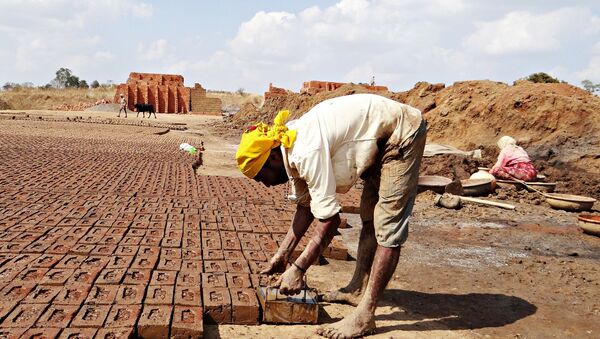This is an extract taken from the book, Blood and Earth, by Professor Kevin Bales, author and lead of the Contemporary Slavery Department at Nottingham University, UK.
Professor Bales is leading a project, that aims to identify South Asian brick kilns — frequently the site of forced labor — in satellite images.
It is hoped that sites will be pinpointed on satellites images taken from space and then the coordinates will be passed to local non-governmental organizations (NGOs) and governments to investigate.
Nearly 70 percent of the estimated 5 million brick kiln workers in South Asia are thought to be working there under force, often to pay off debts.
"I spent a lot of time in the last 20 years in places where there is slavery and there were a number of times where it would strike me that in these far-off places, that were hidden away and using slaves to make bricks or dig mines, that you could locate them in a satellite image," Professor Bales told Sputnik.
"I would often come home from trips and find where I am on Google Earth, and I would see the brick kilns and mines, and I just kept thinking over and over that we should do something," Professor Bales added.

Volunteers working on the project are presented with a series of satellite images taken from Google Earth and they have to click parts of the images that contain brick kilns.
Professor Bales said that the project has been insightful and the data received tells you far more than just the number of sites worldwide and their locations.
"One of the things that people don't understand about satellite imagery is that it has been going for 60 years. You can see the change and the spread, for example, of fish processing camps in the Sundarbans National Park in south west Bangladesh, and the impact of climate change on the location of those slave based camps," Professor Bales told Sputnik.
"You can identify things that are hot at night, so something being burned that shouldn't be burnt in a national forest. It doesn't always mean that slavery is there, but if it's happening in a place where no one should be, you can communicate to people on the ground to go and check it out," he added.
Professor Bales said that the thing with brick kilns is nobody knows how many there are across northern India, Pakistan and Nepal.
The number is 20,000, according to some, and these countries are located in what is otherwise known as the brick belt.
Slavery from Space! Help @UniofNottingham locate slavery activity in India using satellite imagery: https://t.co/dS4FDWgddV. @the_zooniverse pic.twitter.com/UJUgv1O0SV
— Kevin Bales (@kevin_bales) 22 May 2017
"I was in Rajasthan, India, which is part of the brick belt, but it also has a lot of illegal quarrying in protected nature reserves, and both of those use slave labor. So for example, I went to several brick kilns and I was also checking them out on the ground.
"I found whole families caught in a situation where they are living in rough huts, children as young as four working all day long to get mud in to wooden frames, which they pat down and then dry in the sun. The mums are doing that also and the dads are shifting them into the giant kilns, which are large. The kilns are very hot, thousands of degrees, and if they fall in they are instantly incinerated. It's a dangerous place for children. They are malnourished and the women are often sexually assaulted by the men," Professor Bales told Sputnik.
How an Indian village came out of slavery — MA Slavery&Liberation teacher Ginny Baumann @Freedom_Fund explains https://t.co/94zrtpfGkx
— Kevin Bales (@kevin_bales) 28 April 2017
Despite the work revealing some interesting findings, Professor Bales had difficulty gaining support from governments.
After showing the Bangladeshi authorities the pictures of the brick Kilns the response was less than supportive.
"All they said when we showed them the information on slavery sites was, 'well how do you know these children are in slavery?' The fish and shrimp industry is generating billions of dollars and there is a lot of corruption along that supply chain. That said, other countries are now leaning on Bangladesh, based on the information that we have given, saying 'if you don't take some action we will do something,' " Professor Bales said.
Professor Bales hopes that this project will act as one tool that will be able to help improve what governments already know about slavery, and will answer some pertinent questions on where the slavery sites are based.





